Street Elephants
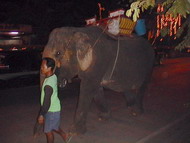 Any organisation involved with the conservation and welfare of Asian elephants has to recognise the importance of the issue of street elephants. The plight of elephants forced to live and work in urban areas is one in which EleAid has been involved since our inception. We first became involved in the issue with our 2003 Bring the Elephants Home Campaign and as a result our first three elephants were all rescued from suffering on city streets.
Any organisation involved with the conservation and welfare of Asian elephants has to recognise the importance of the issue of street elephants. The plight of elephants forced to live and work in urban areas is one in which EleAid has been involved since our inception. We first became involved in the issue with our 2003 Bring the Elephants Home Campaign and as a result our first three elephants were all rescued from suffering on city streets.
What is a Street Elephant?
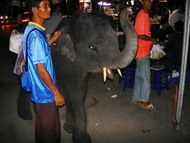 Street elephants are forced by their owners to live and work in an urban environment. The owner or handler makes money by forcing the elephants to perform tricks for people’s entertainment. They also sell over priced bananas or other fruit to passers by so they may feed the animals.
Street elephants are forced by their owners to live and work in an urban environment. The owner or handler makes money by forcing the elephants to perform tricks for people’s entertainment. They also sell over priced bananas or other fruit to passers by so they may feed the animals.
Often, but not always, the targets for the street-begging mahouts are western tourists. The exotic sight of an elephant in a city environment is beguiling to people on holiday and they are often ready to spend a few pounds to interact with elephants. However, most of them are completely unaware of the depths of the suffering of these unfortunate animals. Street elephants are particularly common in Thailand and India, but can be found in other cities throughout Asia.
Why do the Elephants Work the Streets?
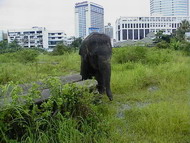 The mahouts work the streets for money, but behind this simple answer there are a number of far more complicated factors.
The mahouts work the streets for money, but behind this simple answer there are a number of far more complicated factors.
Domesticated elephants have been used for work in Asia for thousands of years. Tasks have included logging, building, transportation and providing support during wartime. However, in the modern world, the elephant’s strength and intelligence has been made obsolete by machines.
In Thailand, the problems were particularly exacerbated by the logging ban of 1989 when thousands of elephants were put out of work simultaneously. The elephants’ owners, often small families, have seen their animals go from being net wage earners to being a huge drain on their finances. Many traditional mahouts see no option other than to take their elephants to the city to earn an income.
On the other hand, richer and more unscrupulous criminal elements have been buying up high numbers of elephants and renting them out to people who will take them into the cities. They are using the suffering of these mighty animals to line their pockets.
What Problems do the Elephants Suffer?
Elephants are not designed for the urban jungle. These are just some of the appalling ways that street elephants suffer:
Feet
 Most street elephants start work at about 4pm when they begin walking from their hideouts on wasteland to the main entertainment districts. At this time of day, it is still very hot on the roads and the pavements burn the souls of elephant’s feet. Elephant’s feet are designed for walking in jungle and grassland not burning concrete. There is also danger of rubbish. Many elephants live on wasteland that is littered with broken bottles, rusty cans and other hazards. Often they cut their feet and this can lead to infection, blood poisoning and even death.
Most street elephants start work at about 4pm when they begin walking from their hideouts on wasteland to the main entertainment districts. At this time of day, it is still very hot on the roads and the pavements burn the souls of elephant’s feet. Elephant’s feet are designed for walking in jungle and grassland not burning concrete. There is also danger of rubbish. Many elephants live on wasteland that is littered with broken bottles, rusty cans and other hazards. Often they cut their feet and this can lead to infection, blood poisoning and even death.
Sunstroke and Dehydration
 As previously stated, during the day most city elephants hide on wasteland. Often there is no shade for the elephants and they are left unprotected from the ravages of the sun. We have seen the most appalling sunburn on street elephants who are in absolute agony as the skin peels from their backs.
As previously stated, during the day most city elephants hide on wasteland. Often there is no shade for the elephants and they are left unprotected from the ravages of the sun. We have seen the most appalling sunburn on street elephants who are in absolute agony as the skin peels from their backs.
Often they also have inadequate water supplies. They have to rely on their mahouts to bring them water in buckets. This is however hard arduous work and only the most dedicated mahout will bring the 60 gallons a day that the elephant needs.
We found the elephant pictured in Bangkok desperate for water as he lay collapsed from severe dehydration in the heat of the midday sun.
Gastric and Respiratory Problems
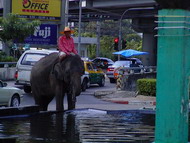 These are both very common in city elephants. Elephants have sensitive stomachs yet most of the diet of a street elephant is contaminated by pollution, pesticides or both.
These are both very common in city elephants. Elephants have sensitive stomachs yet most of the diet of a street elephant is contaminated by pollution, pesticides or both.
Similarly, the air the elephants breathe is choked by pollution and exhaust fumes. For an animal designed to live in a natural environment, the ravages of pollution can play havoc with their respiration.
Traffic and other accidents
 Motor vehicles are a major danger. In 2002, a Thai government minister stated that up 20 elephants a month were involved in traffic accidents. EleAid’s Max was a perfect example of how a traffic accident can leave a street-walking elephant crippled for life.
Motor vehicles are a major danger. In 2002, a Thai government minister stated that up 20 elephants a month were involved in traffic accidents. EleAid’s Max was a perfect example of how a traffic accident can leave a street-walking elephant crippled for life.
There are also many other hazards in the city that can cause elephants to have accidents when they are out of a familiar environment. In 1987, an elephant called Boon Choo fell into an open sewer and died in Bangkok. Others have suffered a similar fate since.
Cruelty and Drugs
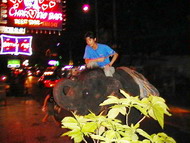 Elephants suffering from any of the problems listed above are unlikely to be the most cooperative of animals when it comes to performing tricks and meeting the general public. Disorientated by a myriad of health problems and forced into the noisy entertainment areas with booming music and confusing neon lights, the elephants can be difficult to control. To keep them in line, the mahouts are often brutal with their discipline and many elephants endure shocking physical abuse with the ankush.
Elephants suffering from any of the problems listed above are unlikely to be the most cooperative of animals when it comes to performing tricks and meeting the general public. Disorientated by a myriad of health problems and forced into the noisy entertainment areas with booming music and confusing neon lights, the elephants can be difficult to control. To keep them in line, the mahouts are often brutal with their discipline and many elephants endure shocking physical abuse with the ankush.
The animals also suffer from extreme fatigue and to combat the tiredness it is commonplace for mahouts to drug the elephants with amphetamines to keep them on the move. EleAid has observed many street elephants with cloudy, dead eyes which is the classic symptom of drugging.
Solutions?
 In Thailand it is illegal for elephants to be living in urban areas. The government tries to enforce the law but it is very difficult. The mahouts hide their elephants and constantly move them to different areas of the city. However, even when elephants are located there are great difficulties. The average city police officer has no idea how to deal with a four-tonne elephant and often it is easier for law enforcement to turn a blind eye to the problem. Occasionally, the government brings in experienced mahouts and purges the city, but it is only a matter of time before the elephants are sneaked back in and are on the streets again.
In Thailand it is illegal for elephants to be living in urban areas. The government tries to enforce the law but it is very difficult. The mahouts hide their elephants and constantly move them to different areas of the city. However, even when elephants are located there are great difficulties. The average city police officer has no idea how to deal with a four-tonne elephant and often it is easier for law enforcement to turn a blind eye to the problem. Occasionally, the government brings in experienced mahouts and purges the city, but it is only a matter of time before the elephants are sneaked back in and are on the streets again.
To be truly effective, any solution must be holistic and comprehensive rather than relying on occasional purges and ad hoc involvement. Firstly an alternative means of earning a living must be made available to the elephants and their keepers. Whether it is working in the tourist business or with the forestry commission patrols, there must be an incentive for the mahouts to remove their elephants from the streets.
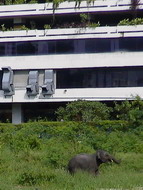 This should be coupled with a corresponding increase in the severity of the penalties for taking elephants back into urban areas. Currently, the fines for an elephant in the city are often laughably small and can be made back with a few hours of begging. This needs to be dramatically increased. the refusal to pay fines should lead to the forfeiture of the elephant.
This should be coupled with a corresponding increase in the severity of the penalties for taking elephants back into urban areas. Currently, the fines for an elephant in the city are often laughably small and can be made back with a few hours of begging. This needs to be dramatically increased. the refusal to pay fines should lead to the forfeiture of the elephant.
Thirdly, enforcement should be dramatically improved. Specialist elephant teams should be set up in cities with an elephant problem and they should be given the resources necessary to carry out the job effectively. Potentially, they could operate in tandem with NGO’s who could provide the elephant handling skills.
EleAid strongly advocates the adoption of the above measure for dealing with the problem of street elephants. However, it requires real commitment on behalf of city governments and other authorities to see them implemented. In the meantime, we urge the public and tourists who encounter street elephants to refrain from handing money to the mahouts. Of course the natural reaction on being confronted by a street elephant is to feed them but these well-intentioned actions merely serve to perpetuate the problem.


